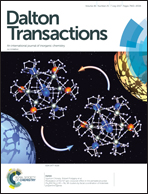Polymer [Pd(CH2SO2C6H4Me)2]n, a precursor to remarkably stable Pd organometallics†
Abstract
A polymer [Pd(CH2SO2C6H4Me)2]n is obtained by thermolysis of cis-[Pd(CH2SO2C6H4Me)2(NCMe)2] to release the MeCN ligands. The corresponding coordination sites are then occupied by weak Pd–O bonds, easier to break than the previous Pd–N bonds. This allows us to produce from the polymer cis complexes containing ligands weaker than NCMe, such as acetone or water. The complexes cis-[Pd(CH2SO2C6H4Me)2{OC(CD3)2}2], cis-[Pd(CH2SO2C6H4Me)2(OH2)2], and cis-[Pd(CH2SO2C6H4Me)2(OH2){OC(CD3)2}], and cyclic dimers [Pd(CH2SO2C6H4Me)2(OH2)]2 with bridging methylsulphone groups are formed. The Pd : PPh3 : OH2 1 : 1 : 1 reaction of the polymer produces cis-[Pd(CH2SO2C6H4Me)2(OH2)(PPh3)], which isomerizes to trans-[Pd(CH2SO2C6H4Me)2(OH2)(PPh3)], with water O-coordinated to Pd and making hydrogen bonds to the two SO2 groups as seen in its X-ray structure. A similar role is played by RNH2 groups in the structures of trans-[Pd(CH2SO2C6H4Me)2(NH3)(PPh3)] and the dimer μ-(N2H4)(trans-[Pd(CH2SO2C6H4Me)2(PPh3)])2. In addition to these interesting intramolecular hydrogen bonding properties provided by the SO2 groups, the structural and 1H NMR data available suggest that the CH2SO2C6H4Me group is an interesting kind of strong alkyl σ donor, with high trans influence, and forms very stable Pd complexes extraordinarily resistant to reductive elimination and to hydrolysis by water at room temperature.
![Graphical abstract: Polymer [Pd(CH2SO2C6H4Me)2]n, a precursor to remarkably stable Pd organometallics](/en/Image/Get?imageInfo.ImageType=GA&imageInfo.ImageIdentifier.ManuscriptID=C7DT00904F&imageInfo.ImageIdentifier.Year=2017)


 Please wait while we load your content...
Please wait while we load your content...